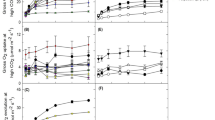Abstract
The proportional light absorptance by photosynthetic tissue (α) is used with chlorophyll (Chl) fluorescence methods to calculate electron transport rate (ETR). Although a value of α of 0.84 is often used as a standard for calculating ETR, many succulent plant species and species with crassulacean acid metabolism (CAM) have photosynthetic tissues that vary greatly in color or are highly reflective, and could have values of α that differ from 0.84, thus affecting the calculation of ETR. We measured ETR using Chl fluorescence and α using an integrating sphere in 58 plant species to determine the importance of applying a measured value of α when calculating ETR. Values of α varied from 0.55–0.92 with a mean of 0.82 across species. Differences between ETR values calculated with measured α values ranged from 53% lower to 12% greater than ETR values calculated with a standard α value of 0.84 and were significantly different in 39 out of 58 species. While measurements of ETR using Chl fluorescence represent a rapid and effective assessment of physiological performance, the value of α needs to be considered. Measurements of α, especially on species with light-colored or reflective photosynthetic tissue, will allow more accurate determination of photosynthesis in succulent and CAM species.
Similar content being viewed by others
Abbreviations
- CAM:
-
crassulacean acid metabolism
- Chl:
-
chlorophyll
- ETR:
-
electron transport rate
- f :
-
energy partitioning factor between PSII and PSI
- PAR:
-
photosynthetically active radiation
- PSI:
-
photosystem I
- PSII:
-
photosystem II
- SE:
-
standard error
- α:
-
absorptance
- ρ:
-
reflectance
- ΦPSII :
-
quantum efficiency of photosystem II
- τ:
-
transmittance
References
Andrade, J.L., Rengifo, E., Ricalde, M.F., Sima, J.L., Cervera, J.C., Vargas-Soto, G.: Light microenvironments, growth and photosynthesis for pitahaya (Hylocereus undatus) in an agrosystem of Yucatan, Mexico. — Agrociencia 40: 687–697, 2006.
Björkman, O., Demmig, B.: Photon yield of O2 evolution and chlorophyll fluorescence characteristics at 77 K among vascular plants of diverse origins. — Planta 170: 489–504, 1987.
Brodribb, T.J., Feild, T.S.: Stem hydraulic supply is linked to leaf photosynthetic capacity: evidence from New Caledonian and Tasmanian rainforests. — Plant Cell Environ. 23: 1381–1388, 2000.
deMattos, E.A., Grams, T.E.E., Ball, E., Franco, A.C., HaagKerwer, A., Herzog, B., Scarano, F.R., Lüttge, U.: Diurnal patterns of chlorophyll a fluorescence and stomatal conductance in species of two types of coastal tree vegetation in southeastern Brazil. — Trees 11: 363–369, 1997.
Egbert, K.J., Martin, C.E.: The influence of leaf windows on the utilization and absorption of radiant energy in seven desert succulents. — Photosynthetica 40: 35–39, 2002.
Ehleringer, J., Björkman, O., Mooney, H.A.: Leaf pubescence: Effects on absorptance and photosynthesis in a desert shrub. — Science 192: 376–377, 1976.
Ehleringer, J.R., Mooney, H.A.: Leaf hairs: effects on physiological activity and adaptive value to a desert shrub. — Oecologia 37: 183–200, 1978.
Genty, B., Briantais, J.M., Baker, N.R.: The relationship between the quantum yield of photosynthetic electron-transport and quenching of chlorophyll fluorescence. — Biochim. Biophys. Acta 990: 87–92, 1989.
Holtum, J.A.M., Winter, K., Weeks, M.A., Sexton, T.R.: Crassulacean acid metabolism in the ZZ plant, Zamioculcas zamiifolia (Araceae). — Am. J. Bot. 94: 1670–1676, 2007.
Jones, T.J., Luton, C.D., Santiago, L.S., Goldstein, G.: Hydraulic constraints on photosynthesis in subtropical evergreen broad leaf forest and pine woodland trees of the Florida Everglades. — Trees 24: 471–478, 2010.
Krause, G.H., Weis, E.: Chlorophyll fluorescence and photosynthesis: The basics. — Annu. Rev. Plant Physiol. Plant Mol. Biol. 42: 313–349, 1991.
Maxwell, K., Johnson, G.N.: Chlorophyll fluorescence — a practical guide. — J. Exp. Bot. 51: 659–668, 2000.
Meinzer, F., Goldstein, G.: Some consequences of leaf pubescence in the Andean giant rosette plant Espeletia timotensis. — Ecology 66: 512–520, 1985.
Nobel, P.S.: Spine Influences on PAR interception, stem temperature, and nocturnal acid accumulation by cacti. — Plant Cell Environ. 6: 153–159, 1983.
Rascher, U., Liebig, M., Lüttge, U.: Evaluation of instant light-response curves of chlorophyll fluorescence parameters obtained with a portable chlorophyll fluorometer on site in the field. — Plant Cell Environ. 23: 1397–1405, 2000.
Ritchie, R.J., Bunthawin, S.: The use of pulse amplitude modulation (PAM) fluorometry to measure photosynthesis in a CAM orchid, Dendrobium spp. (D. cv. Viravuth Pink). — Int. J. Plant Sci. 171: 575–585, 2010.
Schreiber, U., Bilger, W.: III. Progress in chlorophyll fluorescence research: major developments during the past years in retrospect. — Progress Bot. 54: 151–173, 1993.
Silvera, K., Santiago, L.S., Cushman, J.C., Winter, K.: Crassulacean acid metabolism and epiphytism linked to adaptive radiations in the Orchidaceae. — Plant Physiol. 149: 1838–1847, 2009.
Silvera, K., Santiago, L.S., Cushman, J.C., Winter, K.: The incidence of crassulacean acid metabolism in Orchidaceae derived from carbon isotope ratios: a checklist of the flora of Panama and Costa Rica. — Bot. J. Linn. Soc. 163: 194–222, 2010.
Smith, J.A.C., Winter, K.: Taxonomic distribution of crassulacean acid metabolism. — In: Winter, K., Smith, J.A.C. (ed.): Crassulacean Acid Metabolism. Pp. 427–436. Springer-Verlag, Berlin 1996.
Ting, I.P.: Crassulacean acid metabolism. — Annu. Rev. Plant Physiol. 36: 595–622, 1985.
Winter, K., Smith, J.A.C.(ed.): Crassulacean Acid Metabolism. — Springer-Verlag, Berlin 1996.
Acknowledgements
We graciously thank Steven Morgan, Curator of the UC Riverside Botanic Gardens, Doug Holt, Curator of the Botany and Plant Sciences Teaching Collection, and Katia Silvera for use of the orchid species. This project was funded by NSF grant 08-17212 to LSS.
Author information
Authors and Affiliations
Corresponding author
Rights and permissions
About this article
Cite this article
Stemke, J.A., Santiago, L.S. Consequences of light absorptance in calculating electron transport rate of desert and succulent plants. Photosynthetica 49, 195–200 (2011). https://doi.org/10.1007/s11099-011-0026-y
Received:
Accepted:
Published:
Issue Date:
DOI: https://doi.org/10.1007/s11099-011-0026-y




